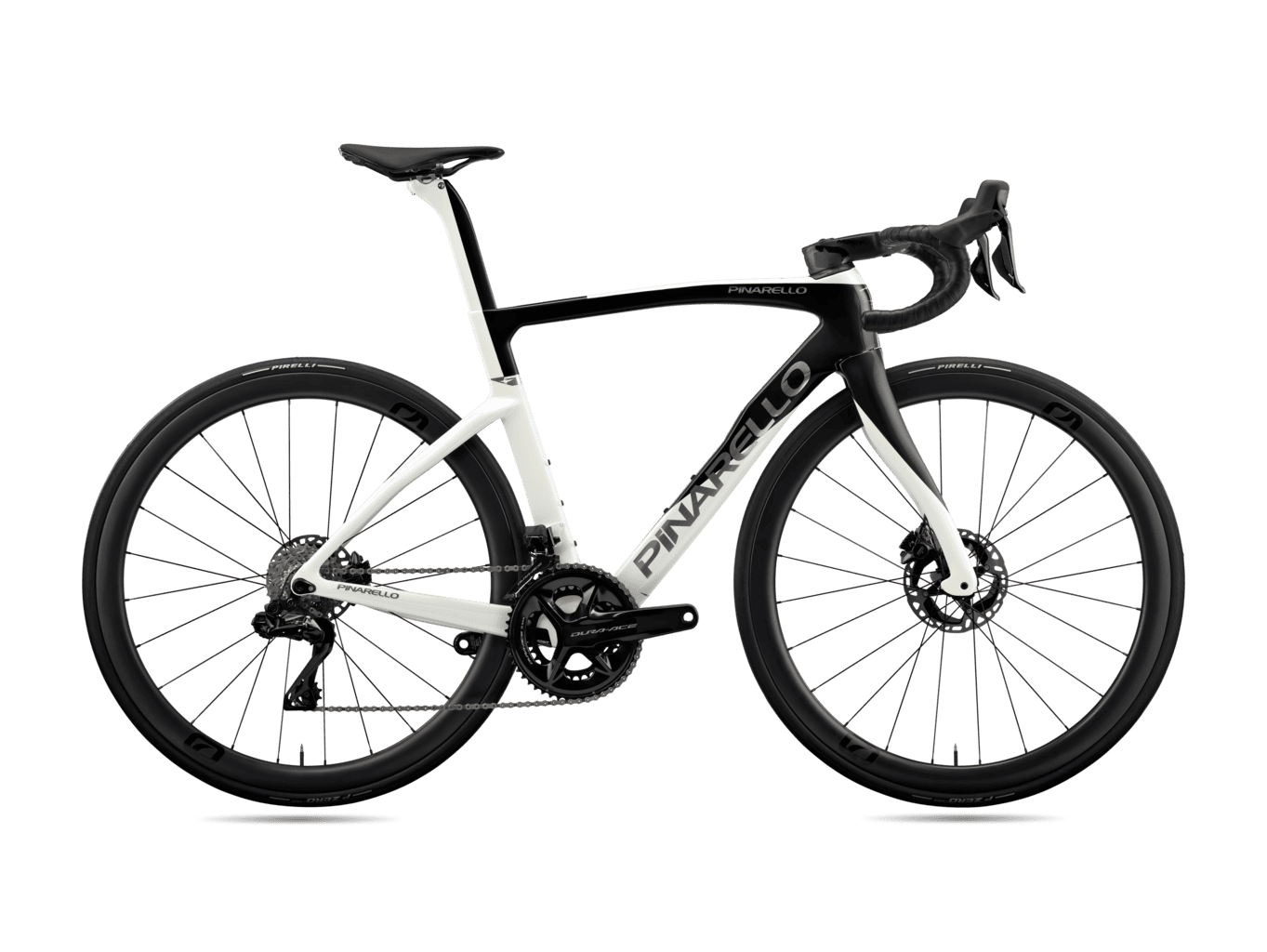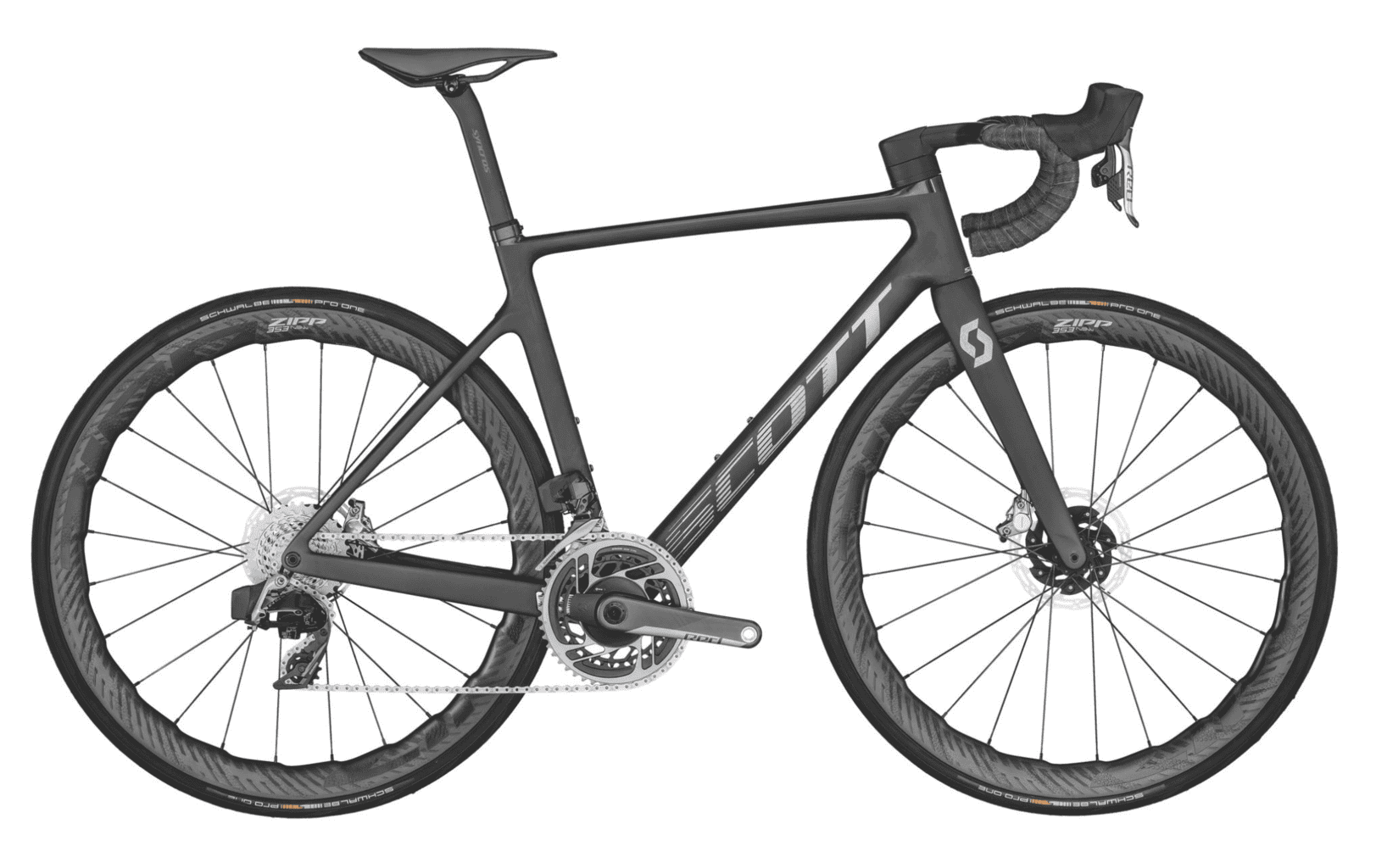In this comparison, I’ll dissect two popular bike models; the Pinarello F vs Scott Addict RC.
I’ll compare their lineups, bike specifications, and suggested retail prices in USD, then discuss the carbon fiber technology (Pinarello TorayCa Carbon and Scott High Modulus Carbon) and frameset technologies.
The goal is to give you a better understanding of Pinarello F and Scott Addict RC to help in your decision-making.
| Pinarello F | Scott Addict RC | |
|---|---|---|
| Type of bike | All-rounder | All-rounder |
| Frame material | TorayCa T900 carbon TorayCa T700 carbon | HMX-SL carbon HMX carbon |
| Frame sizes | 430, 465, 500, 515, 530, 545, 560, 575, 595 | 47, 49, 52, 54, 56, 58, 61 |
| Groupset | Shimano, SRAM (12-speed) | Shimano, SRAM (12-speed) |
| Brakes | Hydraulic disc | Hydraulic disc |
| Cabling | Internal | Internal |
| Price (USD) | Check with local retailers | $4,799 to $15,999 |
Pinarello F

The Pinarello F, announced in February 2023 is a new series of road bikes that replaces the Pinarello Prince, which was a popular model for many years.
The Pinarello F is designed to be a more affordable version of the Pinarello Dogma F, which is the flagship race bike of the Italian brand. The Pinarello F has the same competition geometry as the Dogma F but uses a lower grade of carbon fiber to lower the overall cost. It carries all the distinctive features of the Dogma F, such as the Onda fork, the asymmetric frame, and the TiCR internal cable routing.,
The Pinarello F comes in three models; F9, F7, and F5, and only with Shimano Di2 groupsets. The difference between the F series models lies in the carbon fiber grade and groupset.
| Model | Frame material | Groupset | Wheelset |
|---|---|---|---|
| Pinarello F9 | Toray T900 carbon | Shimano Dura-Ace Di2 (R9200) | Most Ultrafast 40 |
| Pinarello F7 | Toray T900 carbon | Shimano Ultegra Di2 (R8100) | Most Ultrafast 40 |
| Pinarello F5 | Toray T700 carbon | Shimano 105 Di2 (R7100) | Most Ultrafast 40 |
Pinarello bikes
Scott Addict RC

The Scott Addict RC Ultimate is a top-of-the-line model made from the superlight HMX SL Carbon. The Scott Addict RC Pro is next in line with the HMX Carbon. Both models have a fully integrated, one-piece carbon handlebar.
Further down the line are five Scott Addict RC models built with the HMX Carbon. They use a two-piece aluminum handlebar, and the cables are fully hidden. RC stands for Racing Concept, and the Addict RC is Scott’s performance racing bike.
There’s also a women-specific Scott Contessa Addict RC similar to the standard version, except for the touchpoints, saddles, handlebars, and compact cranksets.
| Model | Frame material | Groupset | Wheelset | Retail price (USD) |
|---|---|---|---|---|
| Scott Addict RC Ultimate | Carbon (HMX-SL) | SRAM Red eTap AXS | Zipp 353 NSW | $15,999 |
| Scott Addict RC Pro | Carbon (HMX) | Shimano Dura-Ace Di2 (R9200) | Zipp 303SE | $9,999 |
| Scott Addict RC 10 | Carbon (HMX) | SRAM Force eTap AXS | Syncros Capital 1.0 35 | $7,599 |
| Scott Addict RC 15 | Carbon (HMX) | Shimano Ultegra Di2 (R8100) | Syncros Capital 1.0 35 | $6,799 |
| Scott Addict RC 20 | Carbon (HMX) | SRAM Force eTap AXS | Syncros RP2.0 | $6,299 |
| Scott Addict RC 30 | Carbon (HMX) | SRAM Rival eTap AXS | Syncros RP2.0 | $5,299 |
| Scott Addict RC 40 | Carbon (HMX) | Shimano 105 Di2 (R7100) | Syncros RP2.0 | $4,799 |
Scott Addict RC vs others
Pinarello vs Scott carbon fiber
Pinarello TorayCa
Pinarello uses Torayca carbon in their bikes due to the material’s performance characteristics and the consistency of its quality. Toray’s manufacturing processes ensure a high level of control over the properties of carbon fiber, resulting in a reliable and predictable material.
Different grades of Torayca carbon are used in Pinarello bikes, which are distinguished by their moduli. The T in T1100, T900, T700, and T600 refers to Torayca, and the number denotes the grade of the carbon fiber.
A higher number equates to a higher grade of carbon, which in turn offers more stiffness and less weight, but also typically costs more to produce.
- T1100 carbon is the top Pinarello’s carbon offering. This high-end carbon fiber blend is created for the ultimate stiffness-to-weight ratio. Utilizing the highest quality carbon fiber available, Pinarello designs frames with T1100 Carbon for their flagship, Pinarello Dogma F series.
- T900 carbon is another high-quality carbon fiber offering from Pinarello, albeit slightly less stiff and lightweight than T1100. It’s used in the Pinarello F series road bikes, such as the F9 and F7.
- T700 carbon is a step down from the T900 but still offers a solid balance between weight, stiffness, and cost. It’s found in mid-range models, such as the Pinarello F5.
- T600 carbon is the entry level of Pinarello’s carbon range, is heavier, less stiff, and more comfortable. It’s used in the Endurance road bike series, the Pinarello X.
Scott High Modulus Carbon
Scott implements two primary types of carbon fiber technology in their bicycle frame construction; HMX-SL, HMX, and HMF carbon.
- HMX-SL (High Modulus Xtreme, Super Light) carbon is the pinnacle of Scott’s carbon fiber technology. This innovative blend of carbon fiber is designed for ultimate stiffness and minimal weight. Scott uses HMX-SL Carbon in their highest-end models, such as the premium version of the Scott Addict RC Ultimate and Foil RC Ultimate road bike. These bikes, with HMX-SL Carbon frames, are the go-to choice for professional cyclists competing in world-class races.
- HMX carbon is a level below the HMX-SL, and is still a top-tier carbon material offering a fantastic blend of stiffness and lightweight construction, albeit not as light or rigid as the HMX-SL. It’s an excellent choice for serious and experienced cyclists looking for a high-performance bike without the additional premium.
- HMF (High Modulus Fiber) carbon, may not be as light or stiff as HMX carbon, but it’s still a superior material that contributes to a robust, light, and efficient ride. Scott uses HMF carbon in their bikes that strike a balance between affordability and performance.
Frameset technologies and innovations
Pinarello F and Scott Addict RC framesets incorporate advanced technologies to enhance their bikes’ performance and ride characteristics.
Here’s an overview of the technologies used in each bike model.
Pinarello F
| Name | Description |
|---|---|
| TorayCa carbon fiber | Pinarello F series uses different types of carbon fiber to best suit each rider’s needs. The F9 models use TorayCa T900 UD, which is incredibly strong and lightweight. The F7 models use T900 carbon fiber, which offers the ideal balance between responsiveness, weight, and vibration absorption. |
| Nanoalloy Technology | Implemented in the carbon fiber resin, this technology uses microscopic nanoparticles to form a composite material highly resistant to impacts and fatigue. This means the bike frame maintains its structural integrity under stress and over time, reinforcing the quality of the Pinarello F. |
| TiCR | Total Internal Cable Routing (TiCR) is the state-of-the-art internal cable routing system that sets the standard across the whole bike industry. This system is versatile, accommodating both wireless and electro-mechanical group sets. TiCR completely conceals the cables within the bar/stem or integrated handlebar. This not only enhances the bike’s aesthetic appeal but also significantly improves aerodynamic performance and protects the cables from external elements. |
| Asymmetric frame | The Pinarello F series has an asymmetric frame that compensates for the unbalanced forces generated by the drivetrain. The right side of the frame is stiffer and stronger than the left side, to improve power transfer and efficiency. The asymmetric frame also enhances the handling and stability of the bike |
| FlatBack Profile | The FlatBack Profile is a significant aerodynamic feature in the Pinarello F. Essentially, it’s a truncated aerofoil design that provides an aerodynamic advantage while adhering to the 3:1 rule set by the Union Cycliste Internationale (UCI). By using this design, the bike achieves excellent aerodynamic performance with minimal lateral wind resistance. This means less energy is expended fighting wind resistance, leading to greater speed and efficiency. |
| Onda Fork | The Onda Fork is a distinctive Pinarello technology that has been around since 2000. This fork’s unique design offers precise steering abilities, stability, and a notable reduction of both longitudinal and lateral shocks. It does this by effectively absorbing road vibrations and dissipating them before they can reach the rider, resulting in a smoother, more comfortable ride. |
Scott Addict RC
| Name | Description |
|---|---|
| Oversize Bottom Bracket | The Addict RC features an oversized down tube and bottom bracket intersection, among the widest on the current road bike market. This extensive cross-section and smooth transition handle loads effectively, reducing unwanted frame flex and ensuring efficient power transfer to the drivetrain. |
| Hollow Frame Structure | The entire frame set of Addict RC is built with a hollow structure and has an immaculately clean inside, which significantly reduces the overall weight. |
| One-Piece Handlebar | The Syncros Combo Creston IC handlebar is neat, with all cables completely routed internally through the bar, headset, and into the frame as part of Scott’s new Integrated Cable Routing (ICR). Collaborating with GebioMized, the handlebar design optimizes ergonomics for riders. |
| Evo-Lap Technology | Scott applies Evo-Lap technology in designing the Addict RC, using Finite Element Analysis (FEA) software to simulate different forces on the frame and optimize the carbon lay-up. By modeling the frame and testing stress distribution in different areas, Scott has optimized carbon layers throughout the frame, creating a lightweight yet resilient structure. |
Where to buy
Pinarello retailers
- Pinarello retailers. Use this tool to find your nearest Pinarello retailers.
Scott retailers
- Scott retailers. Use this tool to find your nearest Scott retailers.
- Scott distributors. Use this tool to find your local Scott distributors.

Alex Lee is the founder and editor-at-large of Mr. Mamil. Coming from a professional engineering background, he breaks down technical cycling nuances into an easy-to-understand and digestible format here.
He has been riding road bikes actively for the past 12 years and started racing competitively in the senior category during the summer recently.